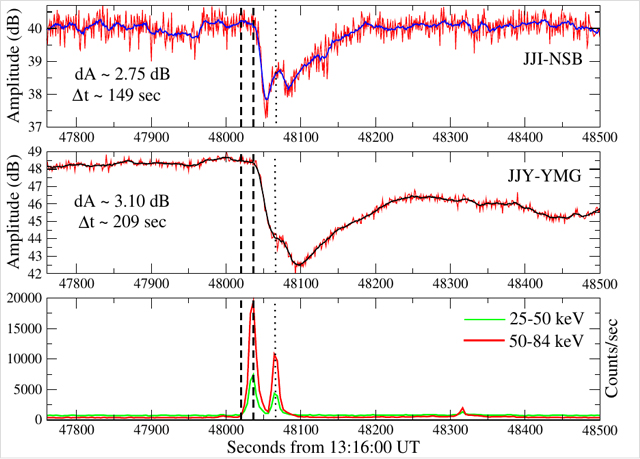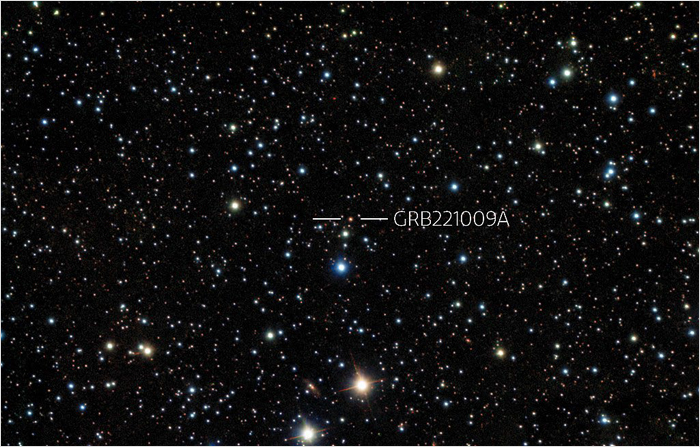Research HighlightsResearch
October 2023 Issue
Impact of the largest Gamma-Ray Burst on the Earth’s ionosphere
Satellites detect gamma-ray bursts most days but rarely do these events affect the ionosphere. However, when they do, they have a measurable impact on the propagation of Low Frequency (LF) and Very Low Frequency (VLF) radio waves there. Now researchers led by Yasuhide Hobara at the University of Electro-Communications have examined the impact of the Gamma-Ray Burst GRB221009A, which took place on 9th October 2022 and is the largest detected gamma-ray burst ever recorded on Earth. They reported their results in the journal Atmosphere on 20th January 2023.
The ionosphere is the upper part of the atmosphere from around 48 km to 965 km above sea level, and it is characterized by extensive ionization of its atoms and molecules due to solar UV and X-ray radiation. At lower heights, the density of air increases so that the resulting electrons and ions soon recombine into neutral particles. However, in the ionosphere, where a high level of ionization persists, the air behaves like a conductor so that the space between the ionosphere and the Earth’s surface acts as a waveguide for the propagation of VLF and LF radio waves.

Fig. 1: Nighttime perturbations of VLF/LF signals transmitted from Japanese transmitters JJI and JJY due to the GRB220910A observed in Nakashibetsu (NSB) and Yamaguchi (YMG) stations (in Japan). The third panel shows the light curve of the GRB in two energy bands 25–50 keV (green) and 50–84 keV (red). The two vertical dashed lines indicate the event trigger and peak flux times. The third dotted line indicates the peak flux time of the subsequent trigger. © 2023 Pal, et al., Atmosphere (Pal, S.; Hobara, Y.; Shvets, A.; Schnoor, P. W.; Hayakawa, M.; and Koloskov, O. First Detection of Global Ionospheric Disturbances Associated with the Most Powerful Gamma Ray Burst GRB221009A. Atmosphere 2023, 14, 217. https:// doi.org/10.3390/atmos14020217)
All sorts of space weather events can affect the ionosphere and its ionization levels, including soft X-rays from solar flares, energetic particle precipitation from geomagnetic storms, and even the daily fluctuation in solar flux between day and night. All these effects on ionization levels lead to measurable perturbations in LF and VLF radio signals. The researchers recorded the impact of GRB221009A on the nighttime ionosphere using a UEC-operated network of VLF/LF receivers in Japan. An example of radio signal perturbations observed in two Japanese stations Nakashibetsu (NSB) and Yamaguchi (YMG) due to the GRB is shown in Fig.1. The radio signals were transmitted from two Japanese transmitters JJI (22.1 kHz) and JJY (40 kHz). Two consecutive bursts of gamma-ray photons are seen in the light curve of the GRB as observed by satellite and displayed in the third panel in two separate energy bands. They also took data from the Kiel long-wave monitor (KLM) in Germany, SuperSID network in Germany and Poland, and a Ukrainian network, which were in daylight during the gamma-ray burst. Depending on the distance travelled and the frequency of the transmissions, it took anywhere from two minutes to around an hour to recover the radio signals from the perturbation. In general, LF signals took a longer time to recover, likely because they propagate at a height where N2, O2 and O are less dense resulting in slower recombination. Recovery times were also greater for regions exposed during the day than those where it was nighttime, suggesting greater disturbance.
Previous gamma-ray bursts have been observed as perturbations in VLF signals with amplitudes ranging from 0.3 to 26 dB, sometimes taking as long as an hour before the ionized particles recombine and the signal settles to within 25% of its pre-event amplitude. However, the researchers point out in their report that the Gamma-Ray Burst GRB221009A was the “record-breaking event detected so far by any space satellites”. Satellite measurements recorded two peaks in energetic photons, with the most energetic photons at 99 GeV measured 240 seconds after the first trigger “making it a once-in-a-century event”. Measurements of VLF/LF signals also confirmed the two peaks in the gamma-ray burst. Astronomers attribute this event to a supernova explosion from a massive star 2.4 billion light years away from the Earth. They describe it as the “birth cry of a black hole”.
The authors conclude with the prospect of further details of the chemical reactions that lead to the longer recovery times based on theoretical simulations.

Fig. 2: Record-breaking gamma ray burst caught with Gemini: Scientists report the disturbance to the ionosphere by GRB221009A, the largest gamma ray burst on record. Credit: International Gemini Observatory/NOIRLab/NSF/AURA/B. O'Connor (UMD/GWU) & J. Rastinejad & W Fong (Northwestern Univ)Image processing: T.A. Rector (University of Alaska Anchorage/NSF’s NOIRLab), J. Miller, M. Zamani & D. de Martin (NSF’s NOIRLab)
References

Yasuhide Hobara, Professor, Department of Computer and Network Engineering
Sujay Pal, Yasuhide Hobara, Alexander Shvets, Peter Wilhelm Schnoor, Masashi Hayakawa and Oleksandr Koloskov First Detection of Global Ionospheric Disturbances Associated with the Most Powerful Gamma Ray Burst GRB221009A Atmosphere 14, 217 (2023)
- URL : https://doi.org/10.3390/atmos14020217
- DOI : 10.3390/atmos14020217


